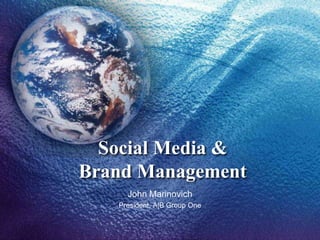Social Media2011
- 1. Social Media & Brand Management John Marinovich President, A|B Group One
- 2. The Social Media World The Digital Revolution Facebook Twitter Connecting Like-Minded Blogs Consumers Content Aggregators Discussion Forums 2
- 3. Social Media Audience Segmentation 1. Producer 13.7% 2. Engager 24.9% 3. Participant 28.4% 4. Lurker 19.7% 5. Abstainer 13.2% SOURCE: SYNCAPSE, Increasing Campaign Effectiveness With Social Media, 2011 3
- 4. Facts • US Internet users spend 3x more minutes on blogs & social networks than on email. • SOURCE: THE NIELSEN COMPANY, NOVEMBER 2010 4
- 5. Facts • LinkedIn drives the most referrals to B2B sites. • SOURCE: LEADFORCE1, JUNE 2010 5
- 6. Facts • Nearly 45% of consumers surf Facebook while watching TV. SOURCE: SYNCAPSE, Increasing Campaign Effectiveness With Social Media, 2011 6
- 7. Facts • 63% of companies using social media say it has increased marketing effectiveness—among other benefits. • SOURCE: MCKINSEY GLOBAL INSTITUTE, DECEMBER 2010 7
- 8. Facts • Social media was the leading “emerging channel” for lead gen in 2010. • SOURCE: UNISFAIR, MAY 25, 2010 8
- 9. Blogging Facts • There are 152,000,000 blogs on the Internet. • Nearly 40% of US companies use blogs for marketing purposes. • Companies that blog have55% more website visitors. SOURCE: EMARKETER, AUGUST 2010 9
- 10. Facebook Facts 93% of US adult Internet users are on Facebook. The average Facebook has 1 out of every8 Facebook user become the top minutes online is spends>11 choice for social spent on hours/month sign-in. Facebook. on Facebook. SOURCES: BUREAU OF LABOR STATISTICS, JUNE 2010 & FACEBOOK PRESS ROOM, 2011 10
- 11. Impact on Brand Marketing Traditional Media Social Media Surveys, Focus Groups conducted Continuous, detailed feedback from Market Research infrequently with limited numbers customers using online networks Customers contributing Product Development New products created by R&D recommendations on a regular basis One-way marketing from the brand; Customers expect brands to listen and Customer Interaction two-way in store engage with them on a regular basis Brand positioning created with agency Brand positioning created and shared Brand Positioning and delivered to consumers with most engaged, loyal customers Broadcast media with minimal Digital campaigns reach consumers in Targeting targeting an entirely personalized manner Campaigns created over a 6-month Campaigns constantly evaluated and Creative plan evolved based on real-time data 11
- 12. A Framework for Leveraging Social Media Immerse Evaluate Reflect Engage Define SOURCE: Social Media, HBS, 2010 12
- 13. Why Some Brands are Reluctant to Use Social Media Cost and Time Knowledge Risk Incentive Structure Measurement Loss of Control 13
- 14. Brand Considerations With Social Media • Be prepared to hear negative feedback • Are you willing to change your brand based on consumer feedback? • You must be committed to being authentic and open • Will brand advocates appear online and stimulate positive conversations? 14
- 15. The Trade-Off Between Control & Engagement High Engagement Low Low High Control 15
- 16. Dove and Social Media • Dove’s Real Beauty/Evolution Campaign – 13 million+ you tube views • Dove’s Real Beauty/Evolution Parody – 3 million+ you tube views 16
- 17. Social/New Media & Earned Media • The Great Schlepp • Air Force One • BING/Decoded 17
Editor's Notes
- #6: LINKEDINREDDIT DZONETWITTER FACEBOOK STUMBLEUPONSQUIDOODELICIOUS
- #8: INCREASING EFFECTIVENESS OF MARKETINGINCREASING CUSTOMER SATISFACTIONREDUCING MARKETING COSTSREDUCING SUPPORT COSTSREDUCING TIME TO MARKET FOR PRODUCTS/ SERVICESINCREASING PRODUCT/SERVICE INNOVATIONINCREASING REVENUE
- #9: SOCIAL MEDIA 74%VIRTUAL EVENTS 39%MOBILE 34%
- #10: The bottom line is that blogging is like sex. ! You can’t fake it. You can’t fake passion. You can’t fake wanting to engage with the public. If you do, it will ultimately be an unsatisfying experience for both the blogger and their readers.
- #11: FACEBOOK 35%GOOGLE31% YAHOO 13% TWITTER 7% WINDOWS LIVE 6%
- #13: Immerse: Invest sufficient time to learn the language and tools of social mediaReflect: Connect knowledge of social media with your organization’s strategyDefine: Set clear objectives for your social media strategyEngage: Create engaging content that generates excitement and buzzEvaluate: Determine measures of success, gauge progress and modify tactics
- #14: May require too many creatives and too much timeSenior managers are less familiar with new media and therefore eschew itTraditional ad agencies have a strong incentive to maintain the current fee structureGRP and click-thru rates are more comfortable measures than page views and engagementMarketers are accustomed to taking a top-down approach to brand positioning and fear losing control of their brands13
- #17: http://www.youtube.com/watch?v=I0u0wWOMIsE
















